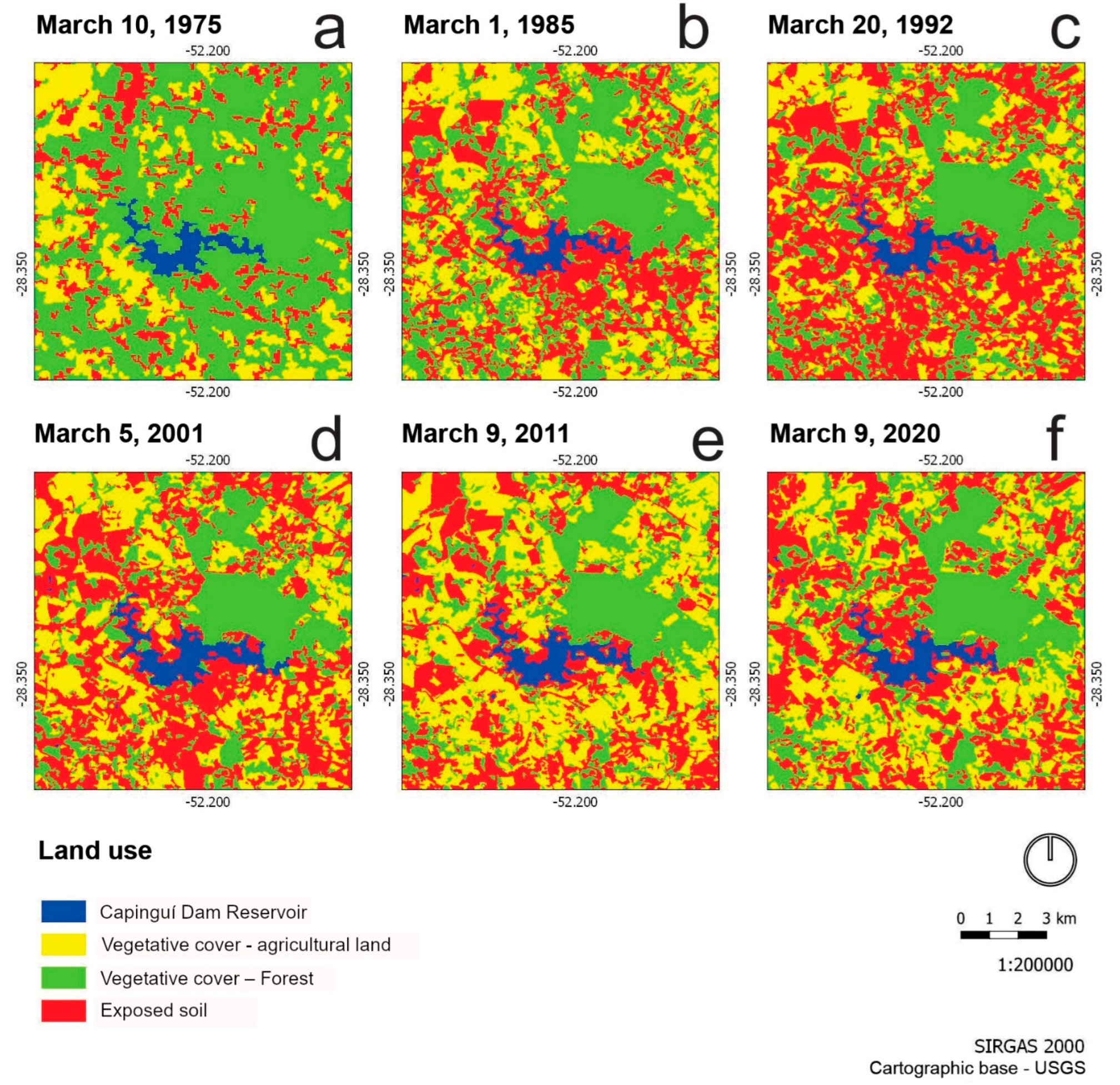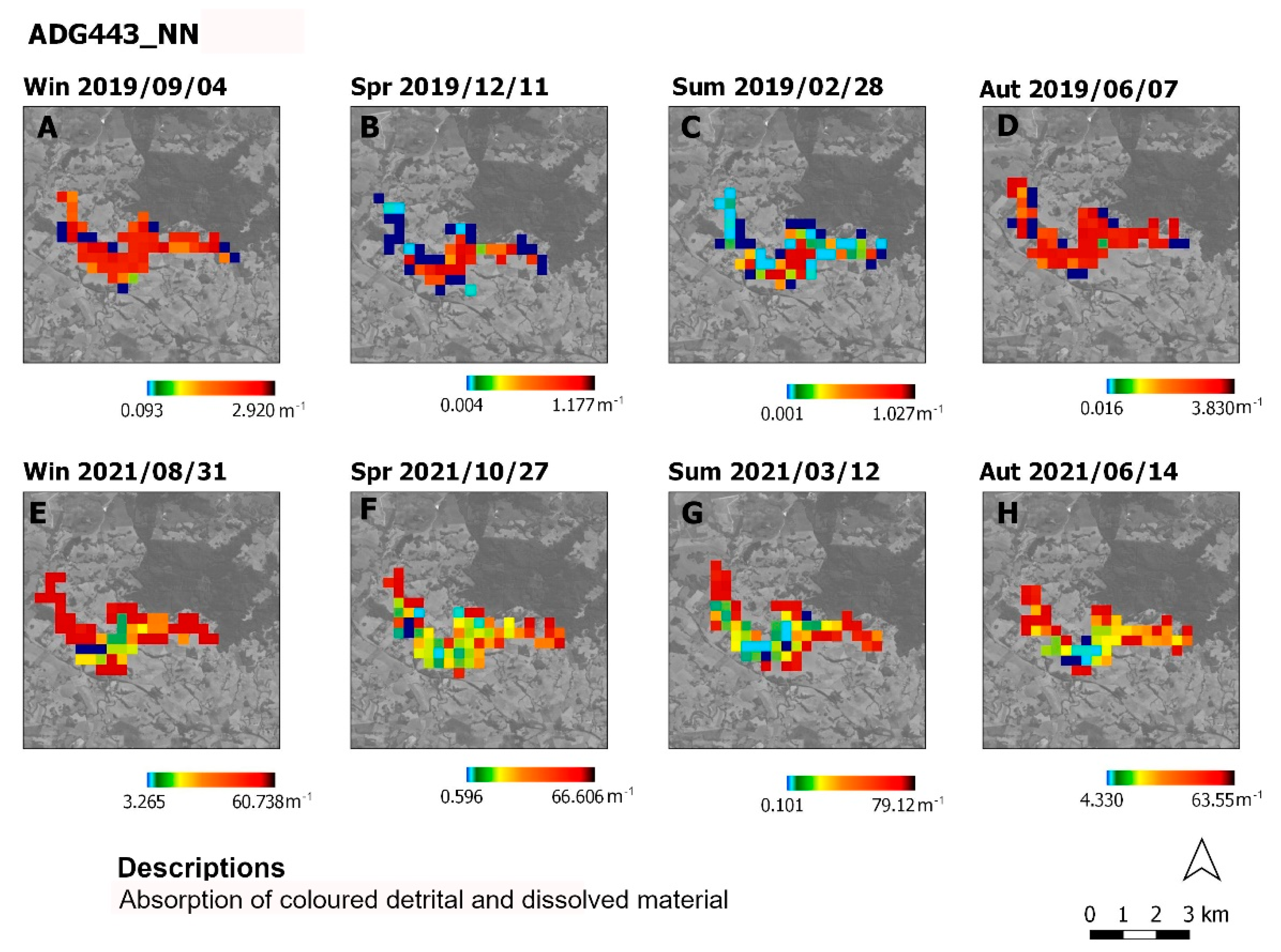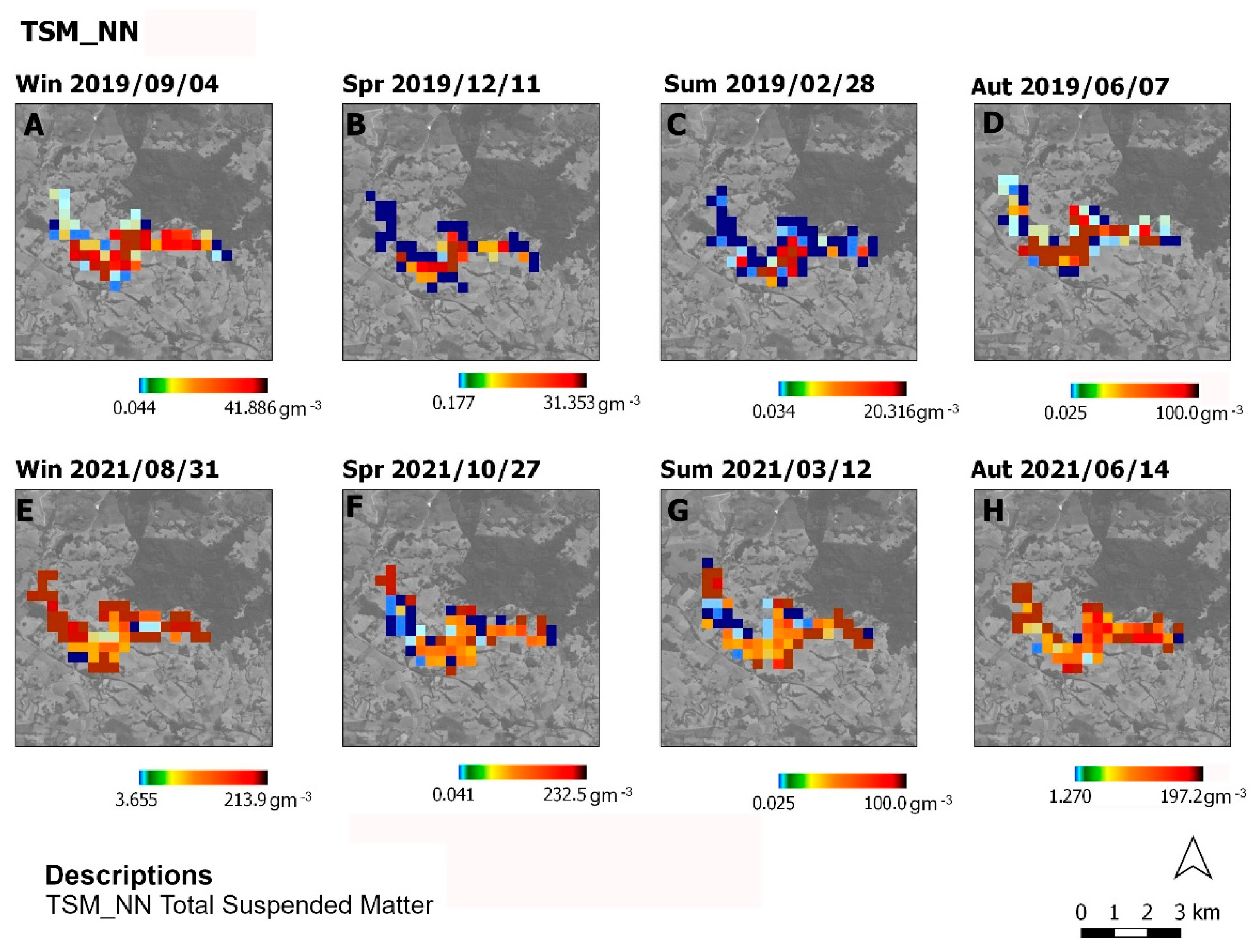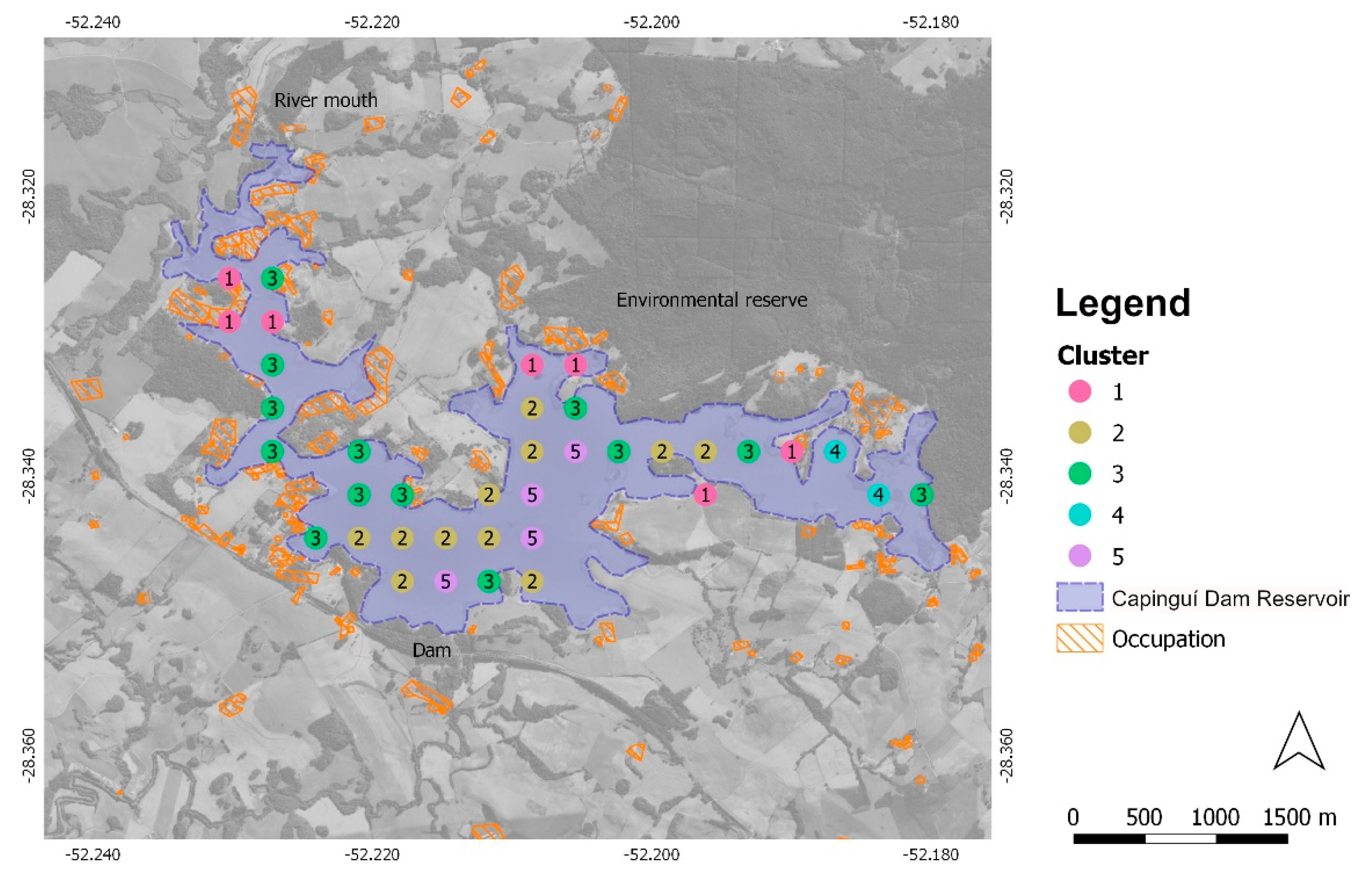Geospatial Analysis with Landsat Series and Sentinel-3B OLCI Satellites to Assess Changes in Land Use and Water Quality over Time in Brazil
Abstract
:1. Introduction
2. Materials and Methods
2.1. Study Area
2.2. Methods of Data Collection
2.3. Analysis of the Water Quality of the Capinguí Dam Reservoir
2.4. Statistical Analysis between Classes
3. Results and Discussion
3.1. Land Use and Occupation
3.2. Analysis of Landscape Metric Composition
3.3. Temporal Evolution of the Landscape
3.4. Landscape Fragmentation
3.5. Geospatial Analysis of Water Quality
4. Conclusions
Author Contributions
Funding
Institutional Review Board Statement
Informed Consent Statement
Data Availability Statement
Acknowledgments
Conflicts of Interest
References
- Yiran, G.A.B.; Ablo, A.D.; Asem, F.E. Urbanisation and domestic energy trends: Analysis of household energy consumption patterns in relation to land-use change in peri-urban Accra, Ghana. Land Use Policy 2020, 99, 105047. [Google Scholar] [CrossRef]
- Chowdhury, S.; Khan, S.; Sarker, M.F.H.; Islam, M.K.; Tamal, M.A.; Khan, N.A. Does Agricultural Ecology Cause Environmental Degradation? Empirical Evidence from Bangladesh. Heliyon 2022, 8, e09750. [Google Scholar] [CrossRef] [PubMed]
- Viana, C.M.; Freire, D.; Abrantes, P.; Rocha, J.; Pereira, P. Agricultural land systems importance for supporting food security and sustainable development goals: A systematic review. Sci. Total Environ. 2022, 806, 150718. [Google Scholar] [CrossRef]
- Parven, A.; Pal, I.; Witayangkurn, A.; Pramanik, M.; Nagai, M.; Miyazaki, H.; Wuthisakkaroon, C. Impacts of disaster and land-use change on food security and adaptation: Evidence from the delta community in Bangladesh. Int. J. Disaster Risk Reduct. 2022, 78, 103119. [Google Scholar] [CrossRef]
- Acuti, D.; Bellucci, M.; Manetti, G. Company disclosures concerning the resilience of cities from the Sustainable Development Goals (SDGs) perspective. Cities 2020, 99, 102608. [Google Scholar] [CrossRef]
- Lu, X.; Zhang, Y.; Lin, C.; Wu, F. Analysis and comprehensive evaluation of sustainable land use in China: Based on sustainable development goals framework. J. Clean. Prod. 2021, 310, 127205. [Google Scholar] [CrossRef]
- Dwivedi, P.P.; Sharma, D.K. Application of Shannon Entropy and COCOSO techniques to analyze performance of sustainable development goals: The case of the Indian Union Territories. Results Eng. 2022, 14, 100416. [Google Scholar] [CrossRef]
- United Nations. Transforming our World: The 2030 Agenda for Sustainable Development. 2015. Available online: https://sustainabledevelopment.un.org/post2015/transformingourworld/publication (accessed on 28 April 2022).
- Dal Moro, L.; Maculan, L.S.; Neckel, A.; Mores, G.de.V.; Pivoto, D.; Bodah, E.T.; Bodah, B.W.; Oliveira, M.L. Geotechnologies applied to the analysis of buildings involved in the production of poultry and swine to the integrated food safety system and environment. J. Environ. Chem. Eng. 2021, 9, 106475. [Google Scholar] [CrossRef]
- Hagos, Y.G.; Andualem, T.G. Geospatial and multi-criteria decision approach of groundwater potential zone identification in Cuma sub-basin, Southern Ethiopia. Heliyon 2021, 7, e07963. [Google Scholar] [CrossRef]
- Andrieu, N.; Dumas, P.; Hemmerlé, E.; Caforio, F.; Falconnier, G.N.; Blanchard, M.; Vayssières, J. Ex ante mapping of favorable zones for uptake of climate-smart agricultural practices: A case study in West Africa. Environ. Dev. 2021, 37, 100566. [Google Scholar] [CrossRef]
- Laufenberg, J.S.; Johnson, H.E.; Doherty, P.F.; Breck, S.W. Compounding effects of human development and a natural food shortage on a black bear population along a human development-wildland interface. Biol. Conserv. 2018, 224, 188–198. [Google Scholar] [CrossRef]
- Bernard, B.M.; Song, Y.; Hena, S.; Ahmad, F.; Wang, X. Assessing Africa’s Agricultural TFP for Food Security and Effects on Human Development: Evidence from 35 Countries. Sustainability 2022, 14, 6411. [Google Scholar] [CrossRef]
- Schürmann, A.; Kleemann, J.; Fürst, C.; Teucher, M. Assessing the relationship between land tenure issues and land cover changes around the Arabuko Sokoke Forest in Kenya. Land Use Policy 2020, 95, 104625. [Google Scholar] [CrossRef]
- Chen, Y.; Lu, C. A Comparative Analysis on Food Security in Bangladesh, India and Myanmar. Sustainability 2018, 10, 405. [Google Scholar] [CrossRef] [Green Version]
- Laborde, J.P.; Wortmann, C.S.; Blanco-Canqui, H.; Baigorria, G.A.; Lindquist, J.L. Identifying the drivers and predicting the outcome of conservation agriculture globally. Agric. Syst. 2020, 177, 102692. [Google Scholar] [CrossRef]
- Bodah, B.W.; Neckel, A.; Maculan, L.S.; Milanes, C.B.; Korcelski, C.; Ramírez, O.; Mendez-Espinosa, J.F.; Bodah, E.T.; Oliveira, M.L. Sentinel-5P TROPOMI satellite application for NO2 and CO studies aiming at environmental valuation. J. Clean. Prod. 2022, 357, 131960. [Google Scholar] [CrossRef]
- Marcinko, C.L.; Samanta, S.; Basu, O.; Harfoot, A.; Hornby, D.D.; Hutton, C.W.; Pal, S.; Watmough, G.R. Earth observation and geospatial data can predict the relative distribution of village level poverty in the Sundarban Biosphere Reserve, India. J. Environ. Manag. 2022, 313, 114950. [Google Scholar] [CrossRef]
- Acharki, S. PlanetScope contributions compared to Sentinel-2, and Landsat-8 for LULC mapping. Remote Sens. Appl. Soc. Environ. 2022, 27, 100774. [Google Scholar] [CrossRef]
- Song, D.X.; Wang, Z.; He, T.; Wang, H.; Liang, S. Estimation and validation of 30 m fractional vegetation cover over China through integrated use of Landsat 8 and Gaofen 2 data. Sci. Remote Sens. 2022, 6, 100058. [Google Scholar] [CrossRef]
- Shang, R.; Zhu, Z.; Zhang, J.; Qiu, S.; Yang, Z.; Li, T.; Yang, X. Near-real-time monitoring of land disturbance with harmonized Landsats 7–8 and Sentinel-2 data. Remote Sens. Environ. 2022, 278, 113073. [Google Scholar] [CrossRef]
- Zhang, X.; Xiao, X.; Qiu, S.; Xu, X.; Wang, X.; Chang, Q.; Wu, J.; Li, B. Quantifying latitudinal variation in land surface phenology of Spartina alterniflora saltmarshes across coastal wetlands in China by Landsat 7/8 and Sentinel-2 images. Remote Sens. Environ. 2022, 269, 112810. [Google Scholar] [CrossRef]
- Song, X.P.; Huang, W.; Hansen, M.C.; Potapov, P. An evaluation of Landsat, Sentinel-2, Sentinel-1 and MODIS data for crop type mapping. Sci. Remote Sens. 2021, 3, 100018. [Google Scholar] [CrossRef]
- Neckel, A.; Oliveira, M.L.S.; Bolaño, L.J.C.; Maculan, L.S.; dal Moro, L.; Bodah, E.T.; Moreno-Ríos, A.L.; Bodah, B.W.; Silva, L.F.O. Biophysical matter in a marine estuary identified by the Sentinel-3B OLCI satellite and the presence of terrestrial iron (Fe) nanoparticles. Mar. Pollut. Bull. 2021, 173, 112925. [Google Scholar] [CrossRef] [PubMed]
- Kusi, K.K.; Khattabi, A.; Mhammdi, N.; Lahssini, S. Prospective evaluation of the impact of land use change on ecosystem services in the Ourika watershed, Morocco. Land Use Policy 2020, 97, 104796. [Google Scholar] [CrossRef]
- Oduro Appiah, J.; Agyemang-Duah, W.; Sobeng, A.K.; Kpienbaareh, D. Analysing patterns of forest cover change and related land uses in the Tano-Offin forest reserve in Ghana: Implications for forest policy and land management. Trees For. People 2021, 5, 100105. [Google Scholar] [CrossRef]
- Sauer, S. Soy expansion into the agricultural frontiers of the Brazilian Amazon: The agribusiness economy and its social and environmental conflicts. Land Use Policy 2018, 79, 326–338. [Google Scholar] [CrossRef]
- Bin, D. Agricultural dispossessions during the 1964–1985 Brazilian dictatorship. Political Geogr. 2021, 84, 102307. [Google Scholar] [CrossRef]
- Roitman, I.; Vieira, L.C.G.; Jacobson, T.K.B.; Bustamante, M.M.da.C.; Silva Marcondes, N.J.; Cury, K.; Silva Estevam, L.; Ribeiro, R.J.da.C.; Ribeiro, V.; Stabile, M.C.; et al. Rural Environmental Registry: An innovative model for land-use and environmental policies. Land Use Policy 2018, 76, 95–102. [Google Scholar] [CrossRef]
- Preto, M.D.F.; Garcia, A.S.; Nakai, R.S.; Casarin, L.P.; Vilela, V.M.D.F.N.; Ballester, M.V.R. The role of environmental legislation and land use patterns on riparian deforestation dynamics in an Amazonian agricultural frontier (MT, Brazil). Land Use Policy 2022, 118, 106132. [Google Scholar] [CrossRef]
- Moraes, L.A.F.de.; Floreano, I.X. LULC zoning in the “Madeira river” settlement, legal Amazon, Brazil, before and after implementation of the rural environmental registry (CAR) (2008–2018). Environ. Dev. 2022, 43, 100725. [Google Scholar] [CrossRef]
- Arvor, D.; Silgueiro, V.; Manzon Nunes, G.; Nabucet, J.; Pereira Dias, A. The 2008 map of consolidated rural areas in the Brazilian Legal Amazon state of Mato Grosso: Accuracy assessment and implications for the environmental regularization of rural properties. Land Use Policy 2021, 103, 105281. [Google Scholar] [CrossRef]
- Leal Filho, W.; Azeiteiro, U.; Alves, F.; Pace, P.; Mifsud, M.; Brandli, L.L.; Caeiro, S.S.; Disterheft, A. Reinvigorating the sustainable development research agenda: The role of the sustainable development goals (SDG). Int. J. Sustain. Dev. World Ecol. 2017, 25, 131–142. [Google Scholar] [CrossRef] [Green Version]
- Coelho Junior, M.G.; Biju, B.P.; Silva Neto, E.C.D.; Oliveira, A.L.D.; Tavares, A.A.D.O.; Basso, V.M.; Turetta, A.P.D.; Carvalho, A.G.D.; Sansevero, J.B.B. Improving the management effectiveness and decision-making by stakeholders’ perspectives: A case study in a protected area from the Brazilian Atlantic Forest. J. Environ. Manag. 2020, 272, 111083. [Google Scholar] [CrossRef]
- IBGE. Brazilian Institute of Geography and Statistics, Demographic Data of 2022—Brazil. 2022. Available online: https://cidades.ibge.gov.br/brasil/rs/passo-fundo/panorama (accessed on 10 March 2022).
- Zafar, M.; Tiecher, T.; Capoane, V.; Troian, A.; dos Santos, D.R. Characteristics, lability and distribution of phosphorus in suspended sediment from a subtropical catchment under diverse anthropic pressure in Southern Brazil. Ecol. Eng. 2017, 100, 28–45. [Google Scholar] [CrossRef]
- USGS. Global Visualization Viewer. 2022. Available online: https://glovis.usgs.gov (accessed on 1 March 2022).
- Wang, J.; Yang, D.; Chen, S.; Zhu, X.; Wu, S.; Bogonovich, M.; Guo, Z.; Zhu, Z.; Wu, J. Automatic cloud and cloud shadow detection in tropical areas for PlanetScope satellite images. Remote Sens. Environ. 2021, 264, 112604. [Google Scholar] [CrossRef]
- Qingyun, F.; Zhaokui, W. Cross-modality attentive feature fusion for object detection in multispectral remote sensing imagery. Pattern Recognit. 2022, 130, 108786. [Google Scholar] [CrossRef]
- Fauvel, M.; Dechesne, C.; Zullo, A.; Ferraty, F. Fast Forward Feature Selection of Hyperspectral Images for Classification With Gaussian Mixture Models. IEEE J. Sel. Top. Appl. Earth Obs. Remote Sens. 2015, 8, 2824–2831. [Google Scholar] [CrossRef]
- Zhang, Y.; Balzter, H.; Zou, C.; Xu, H.; Tang, F. Characterizing bi-temporal patterns of land surface temperature using landscape metrics based on sub-pixel classifications from Landsat TM/ETM+. Int. J. Appl. Earth Obs. Geoinf. 2015, 42, 87–96. [Google Scholar] [CrossRef] [Green Version]
- Abalo, M.; Badabate, D.; Fousseni, F.; Kpérkouma, W.; Koffi, A. Landscape-based analysis of wetlands patterns in the Ogou River basin in Togo (West Africa). Environ. Chall. 2021, 2, 100013. [Google Scholar] [CrossRef]
- Jung, M. LecoS—A python plugin for automated landscape ecology analysis. Ecol. Inform. 2016, 31, 18–21. [Google Scholar] [CrossRef]
- Zatelli, P.; Gobbi, S.; Tattoni, C.; Cantiani, M.G.; La Porta, N.; Rocchini, D.; Zorzi, N.; Ciolli, M. Relevance of the Cell Neighborhood Size in Landscape Metrics Evaluation and Free or Open Source Software Implementations. ISPRS Int. J. Geo-Inf. 2019, 8, 586. [Google Scholar] [CrossRef] [Green Version]
- ESA. European Space Agency. Sentinel-5P Pre-Operations Data Hub—European. 2022. Available online: https://s5phub.copernicus.eu/dhus/ (accessed on 3 March 2022).
- Maroni, D.; Cardoso, G.T.; Neckel, A.; Maculan, L.S.; Oliveira, M.L.; Bodah, E.T.; Bodah, B.W.; Santosh, M. Land surface temperature and vegetation index as a proxy to microclimate. J. Environ. Chem. Eng. 2021, 9, 105796. [Google Scholar] [CrossRef]
- Niu, G.; Ji, Y.; Zhang, Z.; Wang, W.; Chen, J.; Yu, P. Clustering analysis of typical scenarios of island power supply system by using cohesive hierarchical clustering based K-Means clustering method. Energy Rep. 2021, 7, 250–256. [Google Scholar] [CrossRef]
- Borlea, I.D.; Precup, R.E.; Borlea, A.B. Improvement of K-means Cluster Quality by Post Processing Resulted Clusters. Procedia Comput. Sci. 2022, 199, 63–70. [Google Scholar] [CrossRef]
- Ahmad, A.; Khan, S.S. initKmix-A novel initial partition generation algorithm for clustering mixed data using k-means-based clustering. Expert Syst. Appl. 2021, 167, 114149. [Google Scholar] [CrossRef]
- Cusworth, G.; Garnett, T.; Lorimer, J. Agroecological break out: Legumes, crop diversification and the regenerative futures of UK agriculture. J. Rural. Stud. 2021, 88, 126–137. [Google Scholar] [CrossRef]
- Musyoki, M.E.; Busienei, J.R.; Gathiaka, J.K.; Karuku, G.N. Linking farmers’ risk attitudes, livelihood diversification and adoption of climate smart agriculture technologies in the Nyando basin, South-Western Kenya. Heliyon 2022, 8, e09305. [Google Scholar] [CrossRef]
- Burbano-Figueroa, O.; Sierra-Monroy, A.; David-Hinestroza, A.; Whitney, C.; Borgemeister, C.; Luedeling, E. Farm-planning under risk: An application of decision analysis and portfolio theory for the assessment of crop diversification strategies in horticultural systems. Agric. Syst. 2022, 199, 103409. [Google Scholar] [CrossRef]
- David Raj, A.; Kumar, S.; Sooryamol, K. Modelling climate change impact on soil loss and erosion vulnerability in a watershed of Shiwalik Himalayas. Catena 2022, 214, 106279. [Google Scholar] [CrossRef]
- Guo, Y.; Wang, J. Poverty alleviation through labor transfer in rural China: Evidence from Hualong County. Habitat Int. 2021, 116, 102402. [Google Scholar] [CrossRef]
- Reisman, E. Protecting provenance, abandoning agriculture? Heritage products, industrial ideals and the uprooting of a Spanish turrón. J. Rural. Stud. 2022, 89, 45–53. [Google Scholar] [CrossRef]
- Langewitz, T.; Wiedner, K.; Polifka, S.; Eckmeier, E. Pedological properties related to formation and functions of ancient ridge and furrow cultivation in Central and Northern Germany. Catena 2021, 198, 105049. [Google Scholar] [CrossRef]
- Arora, A.; Pandey, M.; Mishra, V.N.; Kumar, R.; Rai, P.K.; Costache, R.; Punia, M.; Di, L. Comparative evaluation of geospatial scenario-based land change simulation models using landscape metrics. Ecol. Indic. 2021, 128, 107810. [Google Scholar] [CrossRef]
- Estoque, R.C.; Ooba, M.; Togawa, T.; Hijioka, Y.; Murayama, Y. Monitoring global land-use efficiency in the context of the UN 2030 Agenda for Sustainable Development. Habitat Int. 2021, 115, 102403. [Google Scholar] [CrossRef]
- Vasiliev, D.; Greenwood, S. Making green pledges support biodiversity: Nature-based solution design can be informed by landscape ecology principles. Land Use Policy 2022, 117, 106129. [Google Scholar] [CrossRef]
- Hargis, C.D.; Bissonette, J.A.; David, J.L. The behavior of landscape metrics commonly used in the study of habitat fragmentation. Landsc. Ecol. 1998, 13, 167–186. [Google Scholar] [CrossRef]
- Mungai, L.M.; Messina, J.P.; Zulu, L.C.; Qi, J.; Snapp, S. Modeling Spatiotemporal Patterns of Land Use/Land Cover Change in Central Malawi Using a Neural Network Model. Remote Sens. 2022, 14, 3477. [Google Scholar] [CrossRef]
- Jaeger, J.A. Landscape division, splitting index, and effective mesh size: New measures of landscape fragmentation. Landsc. Ecol. 2000, 15, 115–130. [Google Scholar] [CrossRef]
- Marine, N.; Arnaiz-Schmitz, C.; Herrero-Jáuregui, C.; Cabrera, M.R.d.L.O.; Escudero, D.; Schmitz, M.F. Protected Landscapes in Spain: Reasons for Protection and Sustainability of Conservation Management. Sustainability 2020, 12, 6913. [Google Scholar] [CrossRef]
- Xu, H.; Xiao, X.; Qin, Y.; Qiao, Z.; Long, S.; Tang, X.; Liu, L. Annual Maps of Built-Up Land in Guangdong from 1991 to 2020 Based on Landsat Images, Phenology, Deep Learning Algorithms, and Google Earth Engine. Remote Sens. 2022, 14, 3562. [Google Scholar] [CrossRef]
- Xie, Z.; Liu, J.; Huang, J.; Chen, Z.; Lu, X. Linking Land Cover Change with Landscape Pattern Dynamics Induced by Damming in a Small Watershed. Remote Sens. 2022, 14, 3580. [Google Scholar] [CrossRef]
- Hou, M.; Bao, X.; Ge, J.; Liang, T. Land cover pattern and habitat suitability on the global largest breeding sites for Black-necked Cranes. J. Clean. Prod. 2021, 322, 128968. [Google Scholar] [CrossRef]
- Tang, Y.; Wang, Q.; Tong, X.; Atkinson, P.M. Integrating spatio-temporal-spectral information for downscaling Sentinel-3 OLCI images. ISPRS J. Photogramm. Remote Sens. 2021, 180, 130–150. [Google Scholar] [CrossRef]






| Satellite | Sensor | Worldwide Reference System | Collection Date | Bands/RGB |
|---|---|---|---|---|
| Landsat 2 | MSS | Path 238; Row 079 | 10 March 1975 | RGB674 |
| Landsat 5 | TM | Path 222; Row 080 | 1 March 1985 | RGB543 |
| Landsat 5 | TM | Path 222; Row 080 | 2 March 1992 | RGB543 |
| Landsat 7 | ETM | Path 222; Row 080 | 5 March 2001 | RGB432 |
| Landsat 5 | TM | Path 222; Row 080 | 9 March 2011 | RGB543 |
| Landsat 8 | OLI | Path 222; Row 080 | 17 March 2020 | RGB654 |
| 2019 | Period | Date of Image |
| Summer | 21 December to 20 March | 28 February 2019 |
| Autumn | 21 March to 20 June | 7 June 2019 |
| Winter | 21 June to 20 September | 4 September 2019 |
| Spring | 21 September to 20 December | 11 December 2019 |
| 2021 | Period | Date of Image |
| Summer | 21 December to 20 March | 12 March 2021 |
| Autumn | 21 March to 20 June | 14 June 2021 |
| Winter | 21 June to 20 September | 31 August 2021 |
| Spring | 21 September to 20 December | 27 October 2021 |
Publisher’s Note: MDPI stays neutral with regard to jurisdictional claims in published maps and institutional affiliations. |
© 2022 by the authors. Licensee MDPI, Basel, Switzerland. This article is an open access article distributed under the terms and conditions of the Creative Commons Attribution (CC BY) license (https://creativecommons.org/licenses/by/4.0/).
Share and Cite
Moro, L.D.; Maculan, L.S.; Pivoto, D.; Cardoso, G.T.; Pinto, D.; Adelodun, B.; Bodah, B.W.; Santosh, M.; Bortoluzzi, M.G.; Branco, E.; et al. Geospatial Analysis with Landsat Series and Sentinel-3B OLCI Satellites to Assess Changes in Land Use and Water Quality over Time in Brazil. Sustainability 2022, 14, 9733. https://doi.org/10.3390/su14159733
Moro LD, Maculan LS, Pivoto D, Cardoso GT, Pinto D, Adelodun B, Bodah BW, Santosh M, Bortoluzzi MG, Branco E, et al. Geospatial Analysis with Landsat Series and Sentinel-3B OLCI Satellites to Assess Changes in Land Use and Water Quality over Time in Brazil. Sustainability. 2022; 14(15):9733. https://doi.org/10.3390/su14159733
Chicago/Turabian StyleMoro, Leila Dal, Laércio Stolfo Maculan, Dieisson Pivoto, Grace Tibério Cardoso, Diana Pinto, Bashir Adelodun, Brian William Bodah, M. Santosh, Marluse Guedes Bortoluzzi, Elisiane Branco, and et al. 2022. "Geospatial Analysis with Landsat Series and Sentinel-3B OLCI Satellites to Assess Changes in Land Use and Water Quality over Time in Brazil" Sustainability 14, no. 15: 9733. https://doi.org/10.3390/su14159733
APA StyleMoro, L. D., Maculan, L. S., Pivoto, D., Cardoso, G. T., Pinto, D., Adelodun, B., Bodah, B. W., Santosh, M., Bortoluzzi, M. G., Branco, E., & Neckel, A. (2022). Geospatial Analysis with Landsat Series and Sentinel-3B OLCI Satellites to Assess Changes in Land Use and Water Quality over Time in Brazil. Sustainability, 14(15), 9733. https://doi.org/10.3390/su14159733







